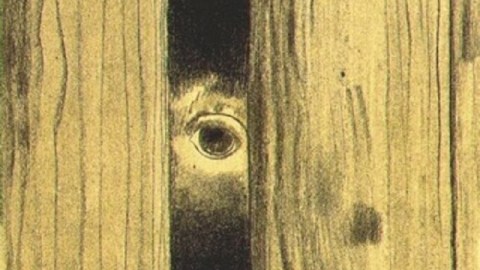Is This the Ultimate Halloween Artist?

What’s your Halloween ideal: Alfred Hitchcock or Wes Craven? If you pick the Master of Suspense over Nightmare on Elm Street, then I have the ultimate Halloween artist for you: Odilon Redon. The late 19th century French Symbolist painter depicted some of the most disturbing images ever made. As described by Dario Gamboni in The Brush and the Pen: Odilon Redon and Literature, Redon found inspiration in haunting tales of literature, especially those of Edgar Allan Poe, who is the unofficial poet laureate of Halloween. If you’ve never heard of Odilon Redon or seen his work, Halloween is the perfect time to discover this artist so unforgettable it’s spooky.
Gamboni sees Redon as an artist heavily influenced by literature but not enslaved by it. “The second half of the nineteenth century marked a decisive stage in the growing autonomy of the cultural field with regard to religious, political, and economic authority,’ Gamboni writes. Redon found himself within this paradigm shift towards greater and greater independence first of the arts as a whole and then of each individual art, especially the visual arts previously categorized as purely illustrative of writing. A writer himself, Redon thought like a writer, so much of his art has a “writerly” vibe, but never at the cost of the visual literacy he also expressed. The fact that Redon’s first public recognition came from writers such as Joris-Karl Huysmans (whose novel À rebours features an art collector whose tastes run to the Redon-esque) and Émile Hennequin (a close friend of Redon’s whose translation of Poe’s Tales of the Grotesque and Arabesque featured Redon’s illustrations).
As Redon developed the “painter-writer” persona Gamboni explores, Poe’s writing became more and more popular in France, thanks to translations of the stories by Charles Baudelaire and the poems by Stéphane Mallarmé. In many ways, Poe’s 19th century career mirrors Jerry Lewis’ 20th century career—an American visionary embraced by France more quickly than by America. Redon began reading Poe in Baudelaire and Mallarmé’s versions in the 1850s and began responding to Poe in his art as early as the 1860s. Redon even wrote a short story titled “Night of Fear” that borrows heavily from Poe’s “The Tell-Tale Heart.” In 1882, Redon began a series of works he would collect under the title To Edgar Poe, the first of several lithographic tributes to writers Redon would create. “[C]onceived as a tribute to a writer, or ‘for’ that writer’s works,” Gamboni explains, Redon’s To Edgar Poe “allowed him to combine the benefit of a literary association with a maximum of freedom and autonomy.” Thus, Redon could ride the Poe buzz while retaining enough independence artistically to generate some buzz for himself.
Redon’s charcoal drawing titled The Tell-Tale Heart (detail shown above) both draws directly from the Poe tale and draws away from the source creatively. On one hand, the picture alludes the old man’s eye viewed through a doorway that first haunts the unnamed narrator to the point of murder. On the other hand, the planks surrounding the eye resemble more the flooring beneath which the murderer hides the victim and whose imagined still-beating heart forces the fateful confession. Gamboni calls these “synthetic images” that “condens[e] selected features and moments of their textual referent into a single visual statement with its own dynamics.” More than simple illustration, Redon’s Poe-inspired pictures capture the feel and spirit of the whole tale rather than any single moment.
Through such “synthetic images,” Redon reaches Hitchcock-ian heights, much like the Master of Suspense’s ability to combine a textbook thriller, potboiler mystery, and psycho-sexual drama simultaneously in Vertigo. Redon’s debt to Poe resembles Hitchcock’s debt to earlier filmmakers. “Imagination was… a key concept for Redon [as it was for Poe],” Gamboni believes. “So we need not choose between the relevance of Poe to Redon’s works and the autonomy of those works.” Redon’s art captivates not because he copies Poe’s ideas or images, but rather because he copies Poe’s imaginative drive—the true “tell-tale heart” of the connection between pen and brush. If Poe is the ultimate Halloween author, then Redon—his imaginative soul mate—is the ultimate Halloween artist.
Sadly, Redon felt the sting of the illustrator label strongly enough to reject any and all literary connections by the turn of the 20th century. Marginalized by his bizarre subject matter, Redon toned down his imagination after 1900 and found a more mainstream audience for his art and the financial rewards that such mainstreaming can bring. However, looking back at Redon’s unashamedly literary-influenced art, particularly the Poe pictures, as Gamboni so thoroughly and thought-provokingly does in The Brush and the Pen: Odilon Redon and Literature, a different and more hauntingly arresting artist emerges like a specter from the shadows to scare (and enthrall) us again.
[Image:Odilon Redon. The Tell-Tale Heart (detail), 1883.]
[Many thanks to The University of Chicago Press for providing me with a review copy of The Brush and the Pen: Odilon Redon and Literature by Dario Gamboni (revised and updated edition; translated from the French by Mary Whittall).]




